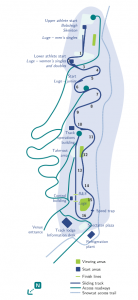 Project Summary
Project Summary
Previous Sports Biomechanics Laboratory projects included the creation of a virtual reality bobsled-driver training simulator. It was based on dynamic model of the motion of a particle or rigid-body model for the sled on the surface of ice tracks. The simulator allowed realistic interaction of a driver with the virtual sled including steering actions of the driver, cockpit motion to mimic that occurring on an actual run, computer generated animations of the oncoming track, and realistic steering
forces transmitted to the hands through a model of the ice-runner interaction. This simulator made it possible for neophyte drivers to increase their skill, and experienced drivers to enhance their technique with nearly instant feedback on what works and what doesn’t, without the expense of travelling to the actual track halfway around the world.
Similar simple geometric models of ice surface shapes and equations of motion of objects on these surfaces can also be used to explain ejection of sliders from ice tracks. Simulations employing these explain why certain track design features can be viewed as proximate causes of ejection from the track and hence design flaws. The paper below studies the interaction of a particle model for the luge sled (or its right runner) with the ice fillet commonly connecting inside vertical walls in turns to the flat track bottom. A numerical example analyzes the 2010 luge accident at the Vancouver Olympics. It shows that this runner-fillet interaction, and specifically the fillet’s positive curvature up the inside wall, can cause a vertical velocity more than sufficient to clear the outside exit wall. In addition the negative curvature of the fillet along the track and the large vertical velocity, explain loss of fillet or wall contact and slider ejection. This exposes the fillet along inside walls as a track design flaw.